Can'tget the Front Brakes Back on 2004 Chevy Malibu Maxx
In the past decade or so, Americans have embraced hatchbacks pretty much in the manner they have embraced ringworm and scabies. Chevrolet is keenly aware of this and prefers to call its new Malibu Maxx a "five-door extended sedan," bypassing the "hatch" and "wagon" identifiers entirely. That's a little like calling a Corvette a "downsized family coupe," but, hey, we can understand GM's nervousness. Of course, it makes you wonder why the General would want to style the Maxx's butt to resemble the stern end of Churchill's bulldog. The thing simply screams hatchback. How big a secret is this, really?
The Malibu sedan ( C/D, November 2003) and the Maxx both ride on GM's Epsilon platform, most familiar to Americans as the Saab 9-3 chassis. That explains the plastic clip in the left corner of the windshield. What, exactly, do the Swedes insert in those clips? Moose schematics?
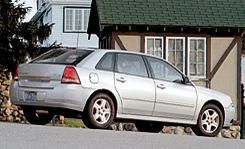
JEFFREY G. RUSSELL
The Maxx LT carries a base price of $24,725. In the mid-size-sedan class, that's a tall pile of clams, although the car is comprehensively equipped. Standard LT fare includes a 200-horse pushrod V-6, a four-speed automatic, anti-lock brakes, 16-inch alloys, a skylight above the rear seat, a CD player, leather seats, adjustable brake and accelerator pedals, a power driver's seat, and a remote starter capable of scaring the mustard out of slackers who happen to be leaning against your empty car. Options on our tester included a rear DVD/audio child-sedation system ($995), OnStar ($695), and XM satellite radio ($325). That nudged the total close to $27,000, navel-deep in V-6 Honda Accord and Toyota Camry territory. Which, for a car bearing the Malibu moniker, strikes us as the fiscal equivalent of poking a stick at the tiger that lunched on Roy.
But let's talk about the Maxx's hinder, which is what everyone notices first. Although this car is six inches longer in wheelbase than the sedan, it is a half-inch shorter in length. That's what you can do when you don't have to hang a trunk behind the rear wheels. The Maxx's hatch swings up to expose a cargo floor roughly 32 by 40 inches. It will accept 23 cubic feet of household miscellany--seven cubic feet beyond what the sedan's trunk can carry, five cubic feet less than what a Subaru Impreza wagon will hold. The aluminum liftgate is light, plus it features two handhold indents lined with a sandpaper-like material that offers astounding grip even in the rain. The cargo bay features a removable parcel shelf that can be fitted at three heights and can hold up to 200 pounds, in case you feel obliged to perform handstands back there. It can even be positioned to jut out of the open hatch, acting as a mini table for tailgate parties that don't exceed four six-packs.
But what truly distinguishes the Maxx is its Maximum Bob rear seats, which perform all manner of circus tricks. For starters, they're on tracks and can be adjusted through nearly seven inches of travel. Slide 'em fully astern, and you'll create 41 inches of legroom. It's like riding in a limo back there, almost too nice to waste on children. The rear seats recline, fold flat, and perform a 60/40 split. Very practical.
Climbing into the back seat is a breeze, too, because the door openings are four inches wider than the Malibu sedan's. Those on our staff who are still procreating report that baby-seat installation in this car is about 75 percent less likely to inflict back injuries. What's more, the front-passenger seatback folds flat so you can carry a nine-foot-long ladder and never expose its rungs to the elements. We flattened all the seats and managed to insert one full-size bicycle. It wasn't easy--some imaginative cursing was required--but it can be done.
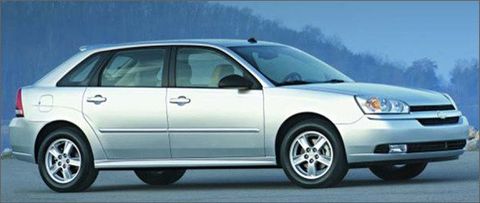
JEFFREY G. RUSSELL
The front-seat cushions are American-butt wide and lack lateral support but are otherwise comfortable. The steering wheel is adjustable for reach and rake, and the pedals are adjustable, too, so there's no trouble finding a perfect driving position. The headliner is a classy gray fabric, and the cabin's understated chrome accents show to nice effect. There's even a credible carbon-fiber motif on the gauge faces, whose white numerals make them easy to read. The Maxx's rotary HVAC controls are easy to understand, although the fan-speed control is so slow to react that it might be elected to Congress. What's more, if you turn the fan knob one tiny increment too far to port, it zings into automatic mode, where you have no control over it at all. Again like Congress.
The fixed skylight is useful for illuminating the rear seat and cargo area. Fact is, there's an airiness to the Maxx's cabin that reliably induces cheer and optimism.
GM has recently made strides in subduing mechanical thrash, and the 3.5-liter V-6 has benefited. Idle quality is excellent, though still behind a Camry V-6's. Cabin noise at idle and at 70-mph cruise are both below a Nissan Altima 3.5SE's.
Throttle tip-in is smooth, and power manifests quickly, although the exhaust note is almost annoying in its ventilator-like blandness. There's a gratifying wallop of power at low revs; disable the traction control, and you can bark the front tires at step-off. Sixty mph arrives in 7.8 seconds, a 10th quicker than a 40,000-mile Camry SE V-6 but 0.8 second behind an Accord EX V-6.
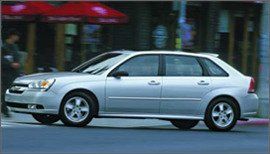
JEFFREY G. RUSSELL
Like its sedan sister, the Maxx features electric power steering with variable assist. Combining steering and electronics to have a natural feel has eluded even the likes of BMW, and Chevrolet has done no better. In any given driving session, the steering feels tight, loose, heavy, and light. Its only consistent trait is a kind of leadenness. Need to know the texture of the road surface? Climb out and feel it with your hands. Under hard accel in 90-degree turns, there's also some torque steer that is occasionally distracting. But on the freeway, the steering is quick to self-center, and the Maxx tracks like a champ.
The four-speed transmission never draws attention to itself except during throttle-induced kickdowns, which are a titch more disruptive than we'd prefer. If you want to shift yourself, there's a rudimentary manumatic. We say rudimentary because you must first manually shift to "L," which then permits you to toggle through gears via a rocker switch on the left side of the shift knob. Even then, you have only three gears at your command, as if GM is worried you might get carried away and try to qualify your Malibu at Monaco. (There are other clues that GM is aiming at a tame crowd—no red to indicate the 5600-rpm redline, for instance. In fact, the only color on the IP is an angry ever-glowing orange "MPH" icon, apparently for drivers not yet familiar with that gauge's function.)
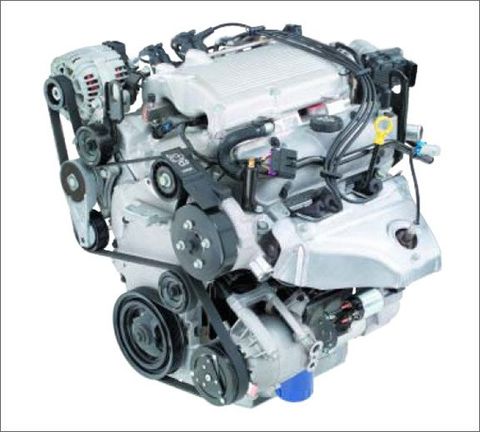
JEFFREY G. RUSSELL
The brake pedal is easy to modulate, and panic stops are straight and controlled. The ABS unfortunately makes such a racket that it's easy to see why it still frightens some drivers. From 70 mph, the Maxx comes to a halt in 191 feet, a few feet below average for this class.
On our handling loop, our test car proved a determined understeerer, but it never embarrassed itself, despite its suburban M+S tires. Body motions were never sloppy, and path control was excellent. Mid-turn potholes and broken pavement rarely altered the car's line. As long as the Maxx's front tires weren't yowling, we could pretty much place the car wherever we wished. On top of that, the ride was never harsh. Here is a ride-and-handling trade-off you'd never have found in a GM economy car just a few years ago. Back then, it was one or the other, never both. The Maxx's Euro-sourced platform feels sturdy and largely flex-free, but it's hard to be sure. That's because too many items attached to it are in motion. There are rattles from beneath the seats, there's what sounds like a heat shield singing the "Star-Spangled Banner" at high revs, and, on rough roads, unspecified suspension pieces now and then resonate in a fashion that makes you wonder if someone forgot to cinch his nuts. The question became, what will the Maxx sound like at 50,000 miles?
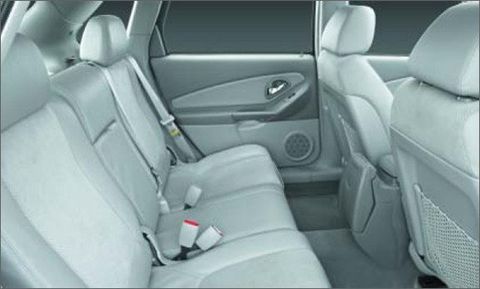
JEFFREY G. RUSSELL
Absent is the vault-like conformity that has become a hallmark of the Camry and Accord, a duo that further surpasses this Chevy in steering feel and in their low levels of NVH. Of course, neither of the Glimmer Twins offers such a commodious rear seat or such a practical, adaptable cargo bay. For that, you'd have to move to, say, Mazda's new 6 sport wagon, which—holy smokes—is priced right atop the Maxx.
Years ago, Paul Simon demonstrated that a one-trick pony can be profitable. Not often, but occasionally.
TONY SWAN
I've gotta say I don't quite get it. There's no shortage of design and engineering talent at General Motors, and under the baton of Bob Lutz, the right kind of talent--"right" defined here as car guys--seems to be rising to the top of the caldron. Then we're confronted with creations such as this one. Lots of utility, yes, plenty of room, okay, terrific chassis, no question. But the packaging! Slab-sided, odd proportions, like a Procrustean Toyota Tercel. And the steering! I can imagine a bunch of guys cruising around on an engineering check ride saying, "Eureka, we nailed it!" Really? For whom? Looks to me as if Mr. Lutz's talent hunt still has a way to go.
STEVE SPENCE
Here's something novel: an all-new GM car that is, in fact, all-new. It's GM's idea of a world car for the 21st century, and it's a pretty good one. The 200-hp V-6 can really run, and unlike some other GM vehicles, the Maxx doesn't howl and wail. The hatch and the fold-down rear seats make it a model of practicality. It's huge inside, an ideal four-seat commuter car. Three problems: The steering is unsettled and nervous and needs constant attention; the car leans and can surface-skip during cornering; and GM may find the almost $25K base price is too high. And why anyone thinks a battleship-gray slab of dashboard is a good styling idea continues to baffle me.
CSABA CSERE
The Maxx is exactly the kind of clever, practical, sensible vehicle that has been missing from Chevrolet showrooms for so long. It's clever, because it transforms the Malibu sedan into an unusually functional blend of wagon and hatchback. It's practical, because this blend yields excellent rear seating combined with great cargo-carrying versatility. And the Maxx is sensible, because it combines this utility with modern driving dynamics, an attractive interior, and an attractive price. With the optional DVD entertainment system, the Maxx is as family friendly as many minivans or SUVs, while sucking less gas and delivering more driving satisfaction.
Specifications
VEHICLE TYPE: front-engine, front-wheel-drive, 5-passenger, 5-door wagon
PRICE AS TESTED: $26,740
ENGINE TYPE: V-6, iron block and aluminum heads
Displacement: 213 cu in, 3498cc
Power (SAE net): 200 bhp @ 5400 rpm
Torque (SAE net): 220 lb-ft @ 3200 rpm
TRANSMISSION: 4-speed automatic
DIMENSIONS:
Wheelbase: 112.3 in Length: 187.8 in
Width: 69.8 in Height: 58.1 in
Curb weight: 3460 lb
C/D-TEST RESULTS:
Zero to 60 mph: 7.8 sec
Zero to 100 mph: 24.1 sec
Street start, 5-60 mph: 8.2 sec
Standing ¼-mile: 16.1 sec @ 86 mph
Braking, 70-0 mph: 171 ft
Roadholding, 300-ft-dia skidpad: 0.78 g
FUEL ECONOMY:
EPA city/highway driving: 22/30 mpg
C/D-observed: 24 mpg
This content is created and maintained by a third party, and imported onto this page to help users provide their email addresses. You may be able to find more information about this and similar content at piano.io
Can'tget the Front Brakes Back on 2004 Chevy Malibu Maxx
Source: https://www.caranddriver.com/reviews/a15132722/chevrolet-malibu-maxx-lt-road-test/